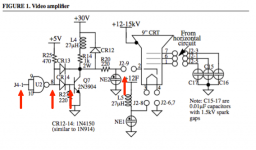cheesestraws
Well-known member
One for the hive memory:
Recently I fixed a Plus AB. Symptoms of broken-ness were:
Further troubleshooting indications:
Schematic (taken from Thomas H. Lee's "Classic Mac Tech Info" document; red arrows are where I probed):
Causality:
Note:
Recently I fixed a Plus AB. Symptoms of broken-ness were:
- Machine booted fine; could hear beep and disc activity happened.
- Mid-grey screen with white lines across it at an angle (horizontal and vertical deflection obviously working, but no video signal). I omitted to take a photo of this. The Dead Mac Scrolls describes a very similar symptom as:

but in this case the raster was not very bright, just middlingly so.
- Occurred after reflowing solder joints on the connectors to fix the omnipresent 'intermittent video, thump it on the side and it works' problem.
Further troubleshooting indications:
- Initially: video signal being seen on J4 pin 1 (from the logic board) but no corresponding signal seen on U2 pin 8. After replacing U2, signal seen at U2 pin 8 and at the base of Q7 but J2 pin 9 hovering constantly around 1V.
Schematic (taken from Thomas H. Lee's "Classic Mac Tech Info" document; red arrows are where I probed):
Causality:
- When resoldering I had somehow fried (presumably with heat) both U2, the 74LS38 open collector NAND IC, and Q7, the video amplification transistor, which is a 2N9304. Both these components tested as failed when removed from the analogue board. Once replaced. video came back.
Note:
- For a very similar symptom, The Dead Mac Scrolls only mentions U2, so I was disappointed when replacing U2 didn't fix it. But at this point Q7 is also obviously fragile. Both are easy to replace, though, and 2N3904 transistors are not uncommon (I just had some in a drawer).

